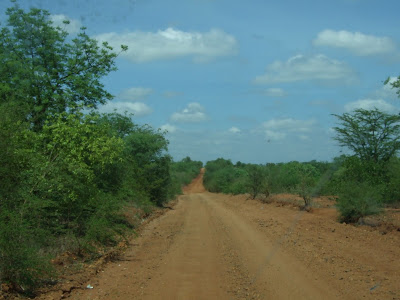South Africa hides the biggest secrets in dark orange termite nests. It is said that termites made the first people out of clay and their saliva. These people wandered through the labyrinth of their new mystical world, trying to find the meaning of life in the constant construction of new corridors. The thermometer rises to 40 degrees Celsius and it just slightly decreases during the night.
Some of the local roads tell of the experiences of thousands of travellers. African dragonflies fly on the hill near Punda Maria, and the far-reaching animal kingdom buzzes at regular meditative intervals. As if swallowed by one cohesive organism (its bowels are light orange and pound with the heat of the dark green African steppes), we feel dizzy and amazed at the same time.
South Africa is nearly like an old acquaintance that surprises anew every day. When a hairy caterpillar falls from a large baobab onto the table, we scream in fright with a three-part voice. The locals watch us curiously and smirk. Step by step we shake off the remnants of an organized, sterile world, and baobab trees and lychees send out their roots in our thoughts. Locals protect themselves from malaria by drinking sweet wormwood (Artemisia annua) tea, while we use repellent several times a day.
We smell of menthol and curious leopards walk around the Punda Maria campsite. Our neighbour, a Dutch pensioner, watches exotic birds feeding on the muddy water of the nearby lake as she irons her husband’s safari-shirt.
Punda Maria
Južná Afrika ukrýva najväčšie tajomstvá v tmavooranžových hniezdach termitov. Vraj prvého človeka pozliepali termity z teplej hliny a slín. Prví ľudia potom blúdili labyrintom ich nového mystického sveta a snažili sa nájsť zmysel v neustálom budovaní nových chodieb. Teplomer vystupuje na 40 stupňov Celzia a ani v noci sa veľmi neochladí.
Niektoré cesty tu rozprávajú zážitky tisícok pocestných. Na kopci naďaleko kempingu Punda Maria lietajú africké vážky a ďalekosiahla ríša zvierat bzučí v pravidelných meditatívnych intervaloch. Akoby nás pohltil jeden súdržný organizmus, V jeho útroby sú svetlooranžové a búšia horúčavou tmavozelených afrických stepí.
Afrika je stará známa, ktorá každý deň prekvapuje nanovo. Keď z veľkého baobabu na stôl spadne chlpatá húsenica, vyľakane vykríkneme trojhlasom. Miestni nás zvedavo pozorujú a uškŕňajú sa. Striasame zo seba zvyšky usporiadaného, sterilného sveta, v myšlienkach nám vyháňajú korienky stromy baobabu a liči. Miestni proti malárii pijú čaj paliny ročnej, zatiaľčo my sa niekoľkokrát za deň natierame repelentom. Voniame po mentole a okolo kempingu Punda Maria sa prechádzajú zvedavé leopardy. Holandská penzionistka pri žehlení safari-košieľ pozoruje exotické vtáctvo napájajúce sa kalnou vodou z neďalekého jazierka.












